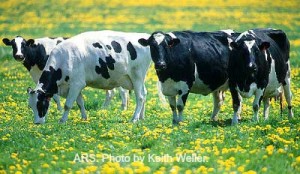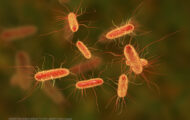Last month’s case of bovine spongiform encephalopathy (BSE), popularly known as “mad cow disease” raised the spectre of that illness in the United States.
 There is evidence that there are two types of BSE: typical and atypical. The typical strain is contracted when the animals are given food made from contaminated cows. A ban on this practice, known as “mammalian-to-ruminant feed ban” was instituted in 1997 in the U.S. and Canada. The ban was enhanced in 2007 to include “specified risk materials from all animal feeds, pet foods, and fertilizers.”
There is evidence that there are two types of BSE: typical and atypical. The typical strain is contracted when the animals are given food made from contaminated cows. A ban on this practice, known as “mammalian-to-ruminant feed ban” was instituted in 1997 in the U.S. and Canada. The ban was enhanced in 2007 to include “specified risk materials from all animal feeds, pet foods, and fertilizers.”
The atypical BSE may be a different strain of the prion. Scientists say that these cases are most likely spontaneous mutations, although it may be transmitted through food or the environment.
There have been four cases of BSE in cattle in the United States: one in 2003 in Washington State, the second in Texas in 2005, the third in Alabama in 2006, and the California dairy cow in April 2012.
In the first case, that cow had typical BSE. It was imported into the country from Canada where it was born, before the Canadian feed ban was established. The second two cases were atypical BSE, which occur as spontaneous mutations and are not related to consuming contaminated feed. Scientists say that the fourth case was also atypical BSE from a spontaneous mutation.
Food Poisoning Bulletin asked Dr. Alfredo DiCostanzo, Professor of Animal Science at the University of Minnesota, about this case.
He said, “the cases found in 2004, 2006, and this most recent case were not related in any way to feeding animal byproducts to cattle. BSE in these cases was the result of a spontaneous prion protein mutation. Therefore, dietary ingredients can effectively be ruled out as the source of the disease in these cases.”
“The feeding ban, preventing feeding mammalian byproducts to ruminant animals, went into effect in 1997,” he continued. “Cattle longevity ranges from 10 to 14 years, and in a few exceptions up to 16 years. Therefore, the likelihood of finding cattle infected with BSE through feeding mammalian protein is declining rapidly.”
We asked if the finding of this case of BSE was a threat to human health. Dr. DiCostanzo replied, “Surveillance for BSE is based on the probability of finding one case of the disease in 1 million cattle. This results in approximately 40,000 animals being sampled yearly from farms, veterinary diagnostic labs, public health laboratories, slaughter facilities, rendering facilities, veterinary clinics, and livestock markets. This enhanced surveillance began in 2004.”
He explained, “considering that chances of finding a BSE case derived from feeding mammalian protein to ruminants (prior to the feeding ban) is decreasing as cattle that may have been exposed are aging or dying rapidly, the intensity of this surveillance effort is actually increasing with time.”
“This and all other cases were found through this surveillance effort. The carcass of this cow was sampled at a rendering facility. Therefore, this animal was never going to enter the food chain. So this posed no threat to human health. Based on the surveillance effort, and decreasing the likelihood of finding cattle with BSE derived from consuming mammalian proteins, concentrating on BSE surveillance on ‘downer’ cows and removing specified risk material from cattle aged 30 months or older, the risk of BSE transmission is effectively low. These efforts are keeping the disease at bay.”
We then asked if the cattle industry is at risk for BSE. He answered, “the atypical variant of BSE will continue to surface as long as spontaneous mutations occur, and they will. Expecting spontaneous prion protein mutations to stop occurring is akin to expected Familial Adenomatous Polyposis [Ed. note: an inherited condition in which polyps form in the large intestines.] mutations not to ever occur again in humans. Therefore, a certain amount of risk for BSE will always be present.”
“The probability of finding typical variant BSE will continue to decline as more time passes since 1997. This probability will be zero once all cattle born prior to 1997 are dead.”
Finally, we wanted to know if feeding cattle proteins derived from poultry, which are fed cattle proteins, is a risk factor. Dr. DiCostanza replied, “based on the science of prions and their transmissions, feeding poultry ruminant-derived protein, and then feeding poultry-derived products to ruminants is not a risk factor for transmission of typical BSE strain. Therefore, this practice is considered safe. Proof of this safety is evident as no cattle have been diagnosed with BSE having been fed non-mammalian animal protein sources.”




